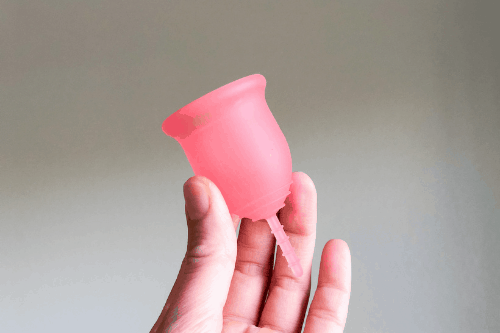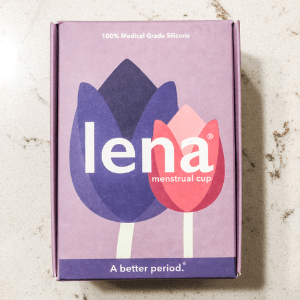You’ve heard about them. You’ve probably seen them at Target. But you’re still wondering, “What are menstrual cups?” This post answers that question and more!
After I learned about menstrual cups, it was at least a full year before I took the plunge and bought one. The thought of how to use a menstrual cup made me a bit queasy.
But I was tired of my tampons leaking, and I was tired of forgetting them when I left the house. I had also started trying to be more eco-friendly, and menstrual cups are a great addition to a low-waste lifestyle.
And now?! I’m a total fan girl! I preach to anyone who will listen about why menstrual cups are the best. (Sometimes it’s awkward.) In fact, if I could take just one personal care item with me to a deserted island, it would be my menstrual cup.
But there definitely are a few things that would’ve been good to know before using it for the first time.
So in this blog post, I’ll discuss a few things, including:
- What is a menstrual cup?
- Menstrual cup pros and cons
- How to use a menstrual cup
- My experience with the menstrual cup
Are ya ready? LET’S GO!

**This post contains affiliate links. If you click and make a purchase, I may receive a small commission (at no additional cost to you). Read my affiliate disclosure for more info.**
What Are Menstrual Cups?
A menstrual cup is a bell-shaped cup made of silicone or rubber that is inserted into the vagina to collect menstrual blood. They are reusable alternatives to tampons and sanitary pads. (There are even reusable menstrual discs, but I don’t discuss those in this post. You can learn more here.)
Menstrual cups provide an air-tight seal in the vagina so you can swim, run, and be active without leaking.
The U.S. Food and Drug Administration (FDA) categorizes menstrual cups as Class II medical devices, which means they need to be registered with the FDA before going on the market. There are a lot of “cheap” cups on the market, so you should check the FDA’s list before you purchase one.
Menstrual Cup Pros
In trying to create a low-tox lifestyle, much of my decision making comes down to three questions:
- Is there a better/safer alternative?
- Does it work?
- Can I afford it?
And as I learned with my menstrual cup review, the answer to all three is yes (with a bit of trial and error).
1. Menstrual cups reduce plastic waste.
First, there’s a lot of plastic that comes with a tampon, and that plastic ends up in a landfill. According to an article on National Geographic’s website, Americans bought 5.8 billion tampons in 2018, and it’s estimated that a single female will use between 5,000 and 15,000 tampons and sanitary pads in her lifetime. Oh, and that’s because the average American woman will menstruate approximately five days a month for 40 years, which is about 6 and a half years of her life.
That’s suuuuper depressing. (If you have a lot of babies running around, you can subtract a few years. Ha.)
Anyway, getting back to the plastic. I’ve never liked cardboard applicators (and they get thrown in the trash, too), and I’ve never liked the non-applicator tampons. That leaves me with plastic. I’ve been using Tampax Pearl tampons for years and the applicator, thin fabric around the absorbent core, string, and wrapper are all made of plastic.
2. Menstrual cups are less expensive than reusable tampons.
Sure, you have an upfront cost with menstrual cups, but they end up being less expensive over the long run. The one I bought, the Lena Menstrual Cup, is $25 on Amazon, and a menstrual cup should last at least a year with proper care and cleaning.
Now let’s compare that to a year’s worth of tampons. A 96-count box of Tampax Pearl regular absorbency tampons from Costco costs about $15, or $0.16 per tampon. On average, if I change my tampon every six hours for five days, I use 20 tampons per period. That’s $3.80 per period, or $38.40 per year. It’ll cost even more for organic tampons.
One ob-gyn states that a menstrual cup can last up to 10 years, but the companies producing the products suggest a much shorter lifespan. (They’re also in the business of selling menstrual cups, so I’m not surprised they suggest replacing them more often.) I couldn’t find a specific recommendation on the Lena Menstrual Cup’s website, but some other brands like Lunette and the Diva Cup recommend replacing them every one to two years. Even using one for just a year, they’re still more cost-effective than reusable products.
3. I can leave the menstrual cup in for up to 12 hours.
When my daughter was a toddler, she used to have what we called blueberry poops. She would eat so many blueberries that her poop would stain her squishy, little bottom blue. We always told her this happened, and it was cute until it backfired on me one afternoon.
We were at the pool for her swim lessons. She was four at the time and it was busy in the restroom/changing area, so I brought her into the stall with me while I went to the bathroom. And when I pulled down my underwear, I noticed that I had an unexpected heavy flow and my tampon had failed. As I was mentally saying four-letter words, Olivia saw the blood and said, “Mama, did you eat too many strawberries and that’s why your underwear is red?”
I think my face was as red as my underwear. Luckily, we were behind the stall door and nobody could see either one!
It’s been so nice not having to worry about changing tampons throughout the day. I used to forget to take them with me when I left the house and then I’d have to stop somewhere to buy them.
4. Menstrual cups don’t contain potentially harmful chemicals.
This is obviously a controversial topic, but I had to throw it in here. The main chemicals of concern in tampons are phthalates, which are found in the fragrance used in scented tampons, and dioxin, which is a byproduct of the rayon found in many tampons.
According to the U.S. Food and Drug Administration (FDA), the levels of dioxin in tampons used to be much higher until manufacturers started using a bleaching process for the fibers that is free from elemental chlorine. The FDA also says that tampons that comply with FDA requirements are safe and effective when used as directed.
A study published in the January 2002 issue of Environmental Health Perspectives stated that Americans are exposed more to dioxins through their diet than through the use of tampons or diapers (for nursing babies). The authors concluded that although dioxins are found in trace amounts in these products, they don’t significantly contribute to dioxin exposure in the United States.
Critics, however, argue that because the vagina is a mucous membrane that absorbs fluids at a higher rate than the skin, it might expose women to higher levels of chemicals, especially over 40 years of menstruating.
If you’re not quite ready to switch to a menstrual cup, at the very least use non-scented, organic cotton tampons.

Menstrual Cup Cons
While there are some disadvantages of menstrual cups, I still think the pros far outweigh the cons.
1. Using a menstrual cup can be messy.
You have to be comfortable inserting your fingers in your vagina for insertion and removal. And you have to be careful not to spill, so make sure you remove it over a toilet or bathtub.
2. Insertion and removal in a public restroom isn’t ideal.
If you’re away from home for extended periods of time, insertion and removal in a public restroom can be tricky. However, many of us won’t need to remove it in a public restroom since we can wear it continually for up to 12 hours unless our flow is heavy. (I haven’t had to remove it in public restroom yet.)
3. There’s a learning curve.
The Lena Cup instructions say that it could take several menstrual cycles to figure out the correct insertion method and placement for your body. I didn’t get it right until the second day of my second cycle.
4. Menstrual cups aren’t one size fits all.
There are many different sizes and shapes of menstrual cups, which makes choosing one a little more difficult. For example, one brand’s “small” size might be equivalent to another brand’s large size. Some brands base their sizing on age and birthing history (whether or not you gave birth vaginally), while others base it on things like flow amount and cervix height.
So here are some things that are helpful to know before choosing a cup… Do you have a heavy flow? Do you have a low cervix? Is your vagina wide? Do you have a sensitive bladder?
For more help, take the menstrual cup quiz from Put A Cup In It to see which one is right for you.
How To Use a Menstrual Cup
My best advice for how to use a menstrual cup is to read your cup’s user guide and FAQs for more in-depth instructions. And keep practicing!
How To Insert a Menstrual Cup
Always have clean hands and a clean cup before inserting. There are different folding methods to insert menstrual cups, and different folds work best for me at different times. For a while, the C-fold worked best for me but I’ve had more luck recently with the punch-down fold. I’ve found it’s easier to insert when I put one foot on the toilet.
Sometimes the cup doesn’t open and seal right away, and I’ll actually feel it “pop” after a few minutes (which feels just as strange as you think it does).
You’ll know that your menstrual cup is inserted properly when you can’t feel it and it doesn’t leak. I’ve found that when my cup isn’t sealed, it feels like it’s sliding down (and it is!). To make sure your menstrual cup is sealed, run your finger along the base to see if there are any folds. You can also try rotating it; if it doesn’t move, then it’s sealed.
The stem of the menstrual cup may stick out. Before you trim it, make sure that your cup fits properly and that you can reach the cup in your vagina. I actually thought I would need to trim the stem, but I eventually realized that I hadn’t inserted the cup far enough.
How To Remove a Menstrual Cup
Start with clean hands. Now let me explain how I remove the menstrual cup without making a mess.
I stand with one foot on the toilet, which I’ve found helps me reach my cup easier. Then once I have a grip on it, I’ll sit on the toilet, pull out the cup, and dump the contents into the toilet.
If your cup sits high in your vagina, you may need to pull gently on the stem to reach the base of the cup. Then move the base from side to side to break the seal and remove.
How To Clean a Menstrual Cup
You should clean your menstrual cup with mild soap and warm water whenever you empty it. The Lena Cup instructions say to use “mild unscented, non antibacterial, water-based, natural if possible soap” because the harsh chemicals can irritate your vagina and damage the cup. I boil my menstrual cup after each period (and I boiled it before using it for the first time).
If you need to clean a menstrual cup in a public restroom, you should remove the cup, dump the contents into the toilet, and wipe the cup with toilet paper. Alternatively, you can rinse the cup with bottled water if you have it, or use single use menstrual cup wipes. Do not use the soap from a public restroom!
Other Things To Know
- Don’t wear a cup during intercourse.
- Menstrual cups will not protect against pregnancy or sexually transmitted diseases.
- Do not wear menstrual cups during prepartum or postpartum bleeding.
- The cup cannot get lost inside your body.
My Experience With the Menstrual Cup
I woke up on my ninth wedding anniversary to the start of my period. Yay me! (My husband, who was out of town anyway, had it much more rough with some kind of stomach bug that had him throwing up all day. We really know how to celebrate around here.)
That first morning, I was going to my 5:30 a.m., spin class and I put in a tampon instead. I wasn’t sure if I’d get the cup in right or how it would feel, so I chose what I knew. Then I volunteered in my daughter’s classroom in the morning, so I didn’t get a chance to try out the Lena Menstrual Cup until that afternoon. And let me just say that was a really good idea because my menstrual cup review didn’t start out very well.
Insertion, Leaking, and Comfort
During my first cycle, I only wore the Lena Cup while at home just in case I leaked or I had to take it out. I did leak while using it, but I just used a thin pantyliner during this transition. (I want to get away from these, too!) I did not, however, do any strenuous physical activity or movement during my first period that would’ve made the cup more likely to leak.
I think the cup is a lot more comfortable to insert than a tampon, which surprised me. When I first used it, I tried every which way to insert it multiple times, and I never had a perfect fit until my second cycle. By this point, I was getting really frustrated and I finally just kind of angrily shoved it in. And it worked! It turned out that I wasn’t inserting it far enough, which meant it wasn’t sealing and kept sliding down.
Some people have to trim the little stem, but once I inserted the menstrual cup far enough, the stem no longer stuck out of my vagina. (Is this getting awkward for anyone else?)
Peeing
I realize now that the biggest indication that I didn’t have the cup inserted correctly was that I couldn’t urinate. So the first time I actually peed with it in, I yelled out of the bathroom to my husband and said, “I’m peeing!!!” I sounded just like my three year old.
Even with proper insertion, menstrual cups can still put pressure on the urethra, which is the little tube your pee comes out of. (Very technical, I know.) According to the ladies who run Put A Cup In It, if you have this problem, your options are to try a rimless cup (like this one) or a softer cup (like the sensitive version of the one I have). Another soft cup option I’ve seen recommended is the Saalt Soft Menstrual Cup.

Final Thoughts on Menstrual Cups
If I learned anything from my menstrual cup review, it’s that there is a learning curve to using a menstrual cup and not to give up too quickly. You may need to try one cup for several cycles before you figure out how to insert it correctly, or you may need to try a cup in a different size, shape, or softness. I am lucky that the best menstrual cup for me was the first (and only) one I purchased!
This post is about menstrual cups.




Leave a Reply